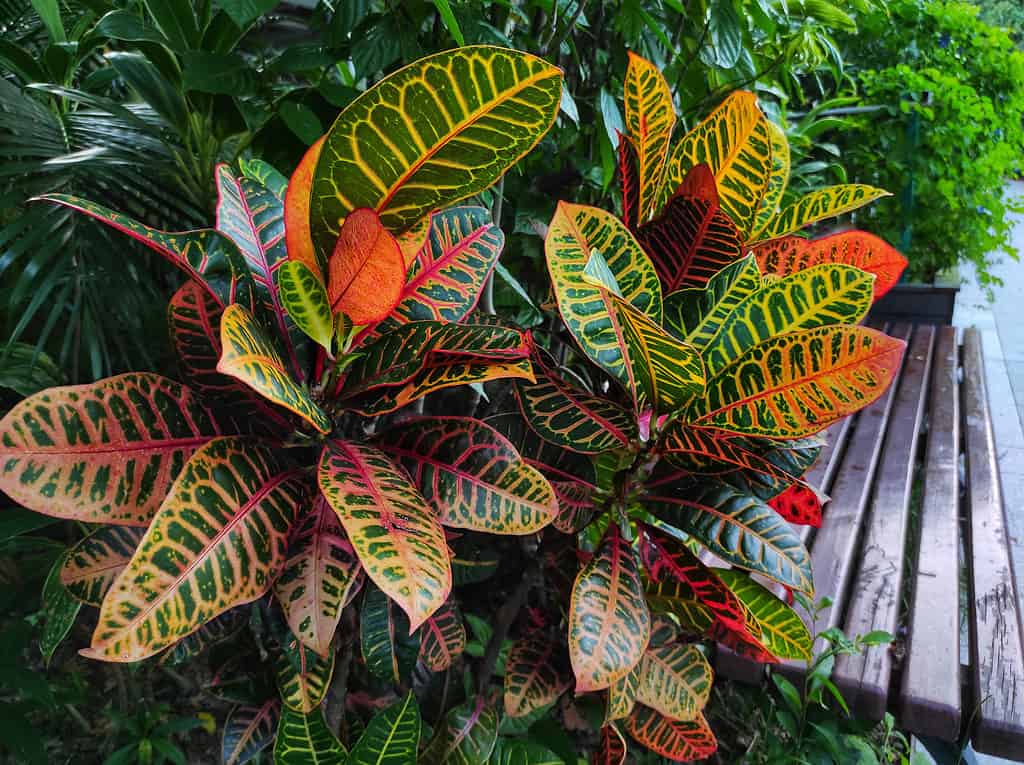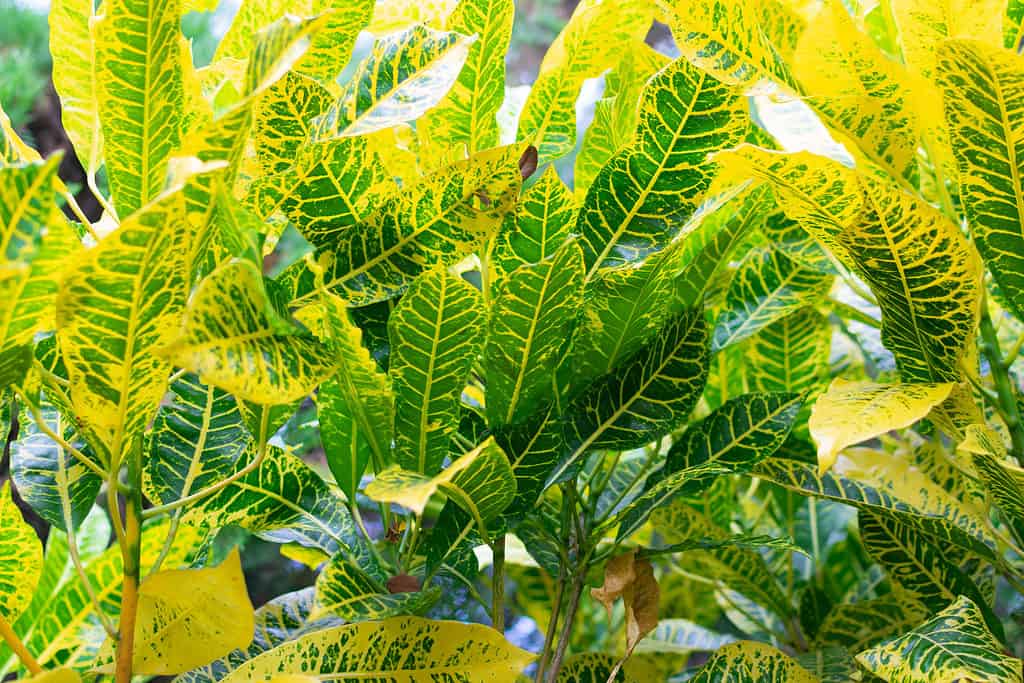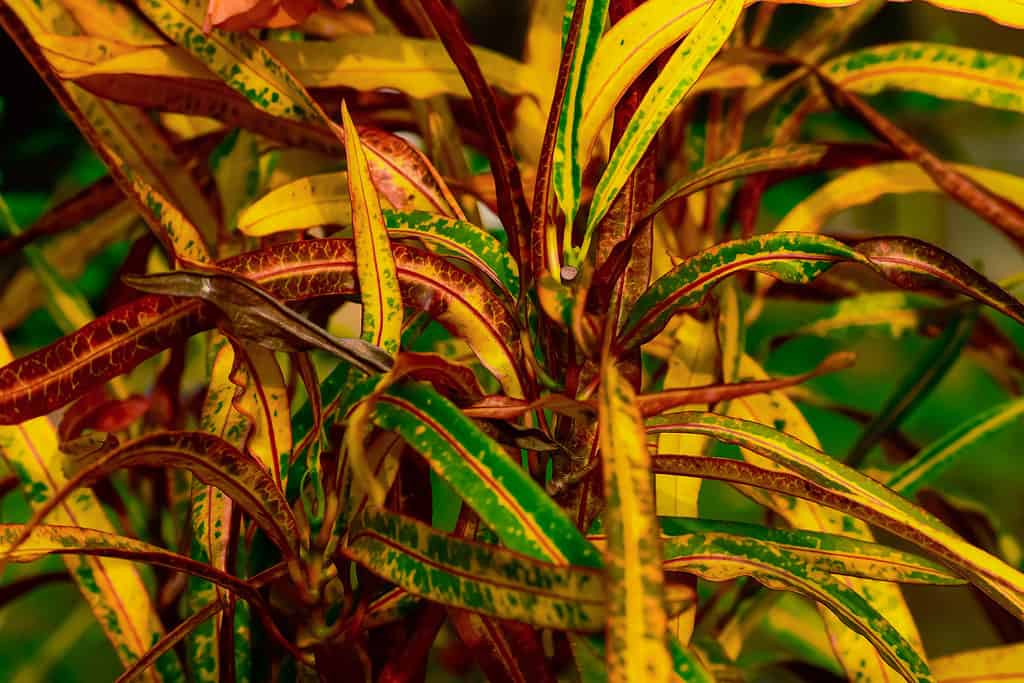More than 100 different types of croton varieties exist. Their leaves come in all the autumnal hues: red, yellow, green, copper, orange, brown, pink, and ivory, with various leaf forms. These colors cover the entire leaf, resulting in an attractive plant beloved by many houseplant enthusiasts. Most require wet soil and well-lit surroundings to flourish.
In this guide, we’ll explore some of the most basic and the rarest croton plant varieties, so you can choose a beautiful croton that fits your home aesthetic.
What is a Croton Houseplant?
The common houseplant croton is popular because of its eye-catching leaves. It belongs to the Euphorbiaceae family and is one of the numerous species of stunning evergreen perennials, shrubs, and trees that are indigenous to tropical Asia and the western Pacific. These plants should not be confused with Croton, a different genus in the same family with more than 700 species, which was formerly wrongly categorized as Croton variegatum.
Numerous varieties of this evergreen shrub or small tree have been created, each with bright and striking leaf hues and patterns. USDA hardiness zones 9 to 11 are the only ones where it is hardy as a perennial. These plants are commonly utilized as landscape shrubs for eye-catching hedges, striking focal points in foliage gardens, or potted plants around temples and buildings in subtropical and tropical regions.
Croton Houseplant Features
This plant’s leaves can be any shade of green that has been variegated with white, pink, orange, red, yellow, or purple in different combinations. As the leaves become older, the color may also vary. Any section of the leaf blade may have markings in the form of blotches or lines that follow the principal veins in predictable or haphazard patterns. It’s not unusual for sports or shoots to look quite different from the parent plant. Similar to the majority of Euphorbiaceae plants, those who are vulnerable to it may get contact dermatitis from the milky sap that flows from damaged stems.
When cultivated inside, it seldom produces blooms. In April, growing in the ground in regions without frost produces little flowers in protracted axillary racemes. The yellowish, petalless female flowers are produced on different inflorescences than the white male blooms, which have five tiny petals and 20 to 30 stamens that create the appearance of a starburst.
Now that we know croton let’s dive into some species and varieties!
Garden Croton
Botanical Name: Codiaeum variegatum
Before we dive into the more diverse varieties, it helps to break down the most basic and well-loved croton species. Crotons are flowering plants from the genus Codiaeum under the spurge family called Euphorbiaceae. Almost all plants in this genus are collectively referred to as crotons, though there are 17 different species available. In most cases, houseplants called crotons are varieties of the Codiaeum variegatum. This croton species is a real delight. It is native to Asia, the Pacific Islands, and Australia. The garden croton is a tropical, monoecious, and evergreen shrub that can grow up to 10 feet tall.

The garden croton (pictured) is the most common species of crotons used for houseplants and landscaping.
©iStock.com/Hanna Yohanna
Gold Dust Croton
Botanical Name: Codiaeum variegatum ‘Gold Dust’
This variety is one of the most popular croton varieties out there. The dark green leaves of the croton plant known as Gold Dust are flecked with gleaming golden gold specks. This evergreen plant requires very little maintenance, is simple to cultivate, and may grow to a height of three to six feet. You shouldn’t be concerned about it taking over your garden because it grows quite slowly. Simply plant it and let it grow. You may also cultivate it indoors.
Because of its stunning and vibrant leaves, the Gold Dust croton is well-known and adored. Its name comes from how its green leaves appear covered with gold dust. It is a slow-growing plant that thrives in groups. This plant thrives when put close to a window that faces south, west, or east. The Gold Dust croton can withstand slightly medium light but really needs lots of bright indirect sunshine.
Mammy Croton
Botanical Name: Codiaeum variegatum ‘Mammy’
This beautiful, simple-to-care-for plant is a lovely addition to any office or house. It also goes by the names Mamey Croton and Croton Mamey. It has huge, thick, lustrous, leathery leaves that twist, curl, and corkscrew as they become bigger. Yellow, pink, red, orange and other vivid hues may be seen on the leaves.
Any room with enough light is a perfect place for the Mammy Croton. You may also put it in a bathroom with a window or skylight because it enjoys high humidity. Just be careful around kids and dogs since this plant is extremely harmful to both people and animals. The seeds can even be potentially fatal.
The Mammy Croton thrives in both partial shade and direct sunlight. The best leaf color will result from giving it some direct sun and strong light. It is best to have a window facing south or west that receives at least two to three hours of direct sunlight each day, but be careful to offer some shade because too much direct sunlight will cause leaf scorching.
Petra Croton
Botanical Name: Codiaeum variegatum ‘Petra’
Croton Petra is a lovely decorative plant with variegated leaves that are an amazing hue. The leaves often have pointy ends and are oval and shiny. The spectrum of colors includes pink, red, orange, yellow, and light and dark green. The leaf veins offer an intriguing variegated texture and are a lighter green. This type is renowned for being quite dramatic, as are many crotons. Insufficient maintenance will cause them to droop or lose their leaves severely.
Petra is a well-liked Codiaeum that, at its finest, is certain to brighten a space and uplift moods. You should have no trouble locating this kind of croton at your neighborhood nursery or plant store because it is by far one of the most well-liked varieties among aficionados of indoor plants. India, Sri Lanka, Malaysia, and the western Pacific islands are the natural habitats of Codiaeum Petra.

The Petra croton (pictured) is beloved for its bright yellow and green foliage.
©iStock.com/SOMNATH MAHATA
Sunny Star Croton
Botanical Name: Codiaeum variegatum ‘Sunny Star’
Crotons are renowned for their vibrant colors and beautiful foliage. Deep green, thick foliage with protracted streaks of brilliant yellow characterize Sunny Star croton. The Sunny Star can withstand a wider range of light than other crotons, making it an easy houseplant to cultivate. This plant, often called Codiaeum variegatum, may be cultivated outdoors in USDA hardiness zones 10 through 11.
The Sunny Star croton would like the dampness of a bathroom or kitchen and can withstand lower light levels. When this croton reaches its maximum size, it works best as a floor plant in a container with a hefty bottom to balance the top growth. Although the Sunny Star croton is thought to be low in toxicity, it should not be grown close to animals or children for safety reasons. A south-facing window’s strong light is ideal for this plant. The hues of the leaves remain lively and brilliant under bright light.
Freckles Croton
Botanical Name: Codiaeum variegatum ‘Freckles’
A colorful and robust plant that thrives well indoors and outside is the Freckles croton. As the plant ages, the leaves will become a deep crimson color. In any house, this plant produces a beautiful tropical show. This plant will thrive in dappled sunshine on the patio or before a sunny window. The temperature, sunshine, and soil type will all affect how quickly these plants develop.
The Freckles croton loves temperatures between 70 and 95 degrees F during the day and over 60 degrees F at night. The plant will start to lose its leaves if it becomes too chilly. It is recommended to cover the plant during a frost if it was planted in soil outside. Outside, the Freckles croton is hardy in USDA hardiness zones 10 and 11. Because it is poisonous if consumed, this plant should be kept out of the reach of kids and animals.
Zanzibar Croton
Botanical Name: Codiaeum variegatum ‘Zanzibar’
This is a slightly rarer plant on our list of croton varieties. The Zanzibar croton variety is a native of the Western Pacific islands, Australia, Malaysia, and Indonesia. It is a unique croton variety as it resembles grass in appearance. It has long, thin leaves that are not all-the-way green. They frequently have orange, purple, and red markings. For anyone seeking a change from the large leaves of this plant’s other varieties, Zanzibar is the perfect plant.
It is best to keep the Zanzibar croton as an indoor plant. Zanzibar croton may grow up to five feet tall and three feet broad outside, becoming the size of a shrub. It thrives in USDA hardiness zones 9 to 11 with some mild shade and moderate watering. These are perennial plants, meaning they come back every year. If the plant freezes and some dies, its root system should allow it to grow again. But in colder regions, it might not endure the cold and will die off completely.

The Zanzibar croton (pictured) is uniquely known for its grass-like foliage.
©RANGINAPHOTOGRAPHY/Shutterstock.com
Victoria Gold Bell Croton
Botanical Name: Codiaeum variegatum ‘Victoria Gold Bell’
This lovely variegated croton with an unusual leaf structure is called the Victoria Gold Bell. The leaf structures are made up of little bell-shaped leaves that are suspended from the larger leaf by a fine thread.
The Victoria Gold Bell croton can be challenging to grow and maintain good health since it needs a least four hours of direct sunlight each day. The plant should be shielded from drafts and excessive heat, and the soil must be properly moistened. The leaves will fall if the plant’s soil is either too dry or too damp. These plants can only live outside, where winter temperatures don’t frequently fall below 50 degrees F. The plants are cultivated inside or in greenhouses in colder climates.
Mother and Daughter Croton
Botanical Name: Codiaeum variegatum ‘Mother and Daughter’
This peculiar plant, the Mother and Daughter croton, has long, thin leaves that appear to have little baby plants hanging from the ends. The green leaves have yellow and red patterns, adding a pop of brightness to any setting. Mother and Daughter crotons are recognized as decorative plants that even bloom because of their large, leathery leaves with a lustrous surface.
Generally speaking, this cultivar should be watered once weekly when the top three inches of soil are dry. Additionally, this cultivar enjoys up to eight hours under grow lights or moderate, indirect sunshine.
How cool are all of these croton varieties? All of these varieties do well in warm temperatures with bright sunlight, making them ideal for both outdoor and indoor uses, provided you can provide them with the regular maintenance they need to thrive.
Want to learn more about the incredible croton plant? Take a look at our complete guide to everything croton-related!
The photo featured at the top of this post is © iStock.com/Anna Yakymenko
FAQs (Frequently Asked Questions)
How many croton varieties are there?
There are over 100 different varieties of croton plants.
Which croton variety is the best?
Each variety has its own benefits, depending on what you want. There are varieties that are perfect for aesthetics, ease of care, low and high temperatures, etc.
How long do crotons live?
This depends on the variety, but on average, the lifespan of an indoor croton is about four years.
Thank you for reading! Have some feedback for us? Contact the AZ Animals editorial team.






